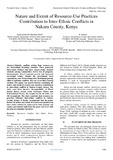| dc.contributor.author | Momanyi, Ruth Zipporah Kerubo | |
| dc.contributor.author | Simiyu, N. | |
| dc.date.accessioned | 2023-05-29T08:03:01Z | |
| dc.date.available | 2023-05-29T08:03:01Z | |
| dc.date.issued | 2023-01-01 | |
| dc.identifier.uri | https://ijisrt.com/assets/upload/files/IJISRT23JAN954.pdf | |
| dc.identifier.uri | http://ir-library.mmust.ac.ke:8080/xmlui/handle/123456789/2207 | |
| dc.description.abstract | Globally, conflicts arising from resource-use are increasingly becoming common. These generatedinter-ethnic violence that have caused death, strained
relations among communities, led to loss of property, displacements, slowed economic growth and increased sex-related crimes. Despite the government, local
communities, and NGOs among other institutions putting effort to minimize conflicts, they are yet to find a lasting solution. This paper was geared towards examining the
nature and extent of resource-use practices contribution to inter-ethnic conflicts in Nakuru County, Kenya. The study used three theories, Incompatibility of Plural
Society theory, Greed versus Grievance Theory and Primordalism Theory. The sample size for the study was 246 respondents. The study concludes that resource-use
practices influence inter-ethnic conflicts in Nakuru County, Kenya. It further recommends that the major factors for nature and extent of resource-use practices on
inter-ethnic conflicts be addressed by both national andcounty government right from the grass root level with the help of community members. | en_US |
| dc.language.iso | en | en_US |
| dc.publisher | International Journal of Innovative Science and Research Technology | en_US |
| dc.subject | Nature, Extent, Resource-Use, Practices, Contribution, Inter-Ethnic, Conflicts County, Kenya | en_US |
| dc.title | Nature and Extent of Resource-Use Practices Contribution to Inter-Ethnic Conflicts in Nakuru County, Kenya | en_US |
| dc.type | Article | en_US |

